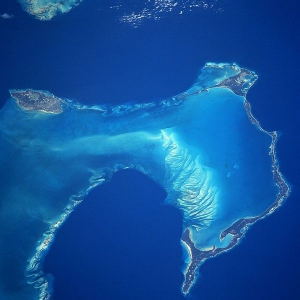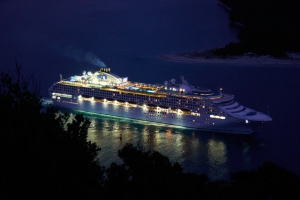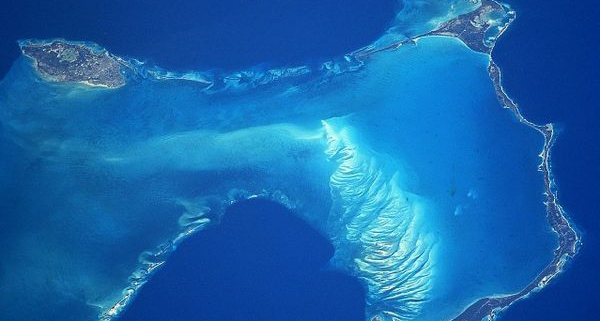The Development Plans of Lighthouse Point, The Bahamas
By: Peter Aronson, SRC Intern
Imagine a beach with soft, white sand and pristine, turquoise waters spotted with deep royal blue from the coral patches that lay below. Scenic rocky cliffs tower over one end of the beach while lush coppice lays 100 feet from the shoreline that young lemon sharks swim along. This area is called Lighthouse Point. It sits at the very southeast end of Eleuthera, an island in The Bahamas. It is a tourist’s paradise, which is why the Bahamian government approved the sale of the area to Disney Cruise Line.
Lighthouse Point was privately owned by an international developer and marketed for large-scale development. Many large-scale developments have been attempted before on Eleuthera, and many have failed, such as Club Med, the Cape Eleuthera Resort, Whale Point Club, and even the Cape Eleuthera Airport (Project Eleuthera, 2015). Such failed developments in the past have had poor impacts. The impacts on nature and the Bahamian economy last much longer than the few years the developments are run for. There is currently one cruise ship port on Eleuthera, just two miles northwest of Lighthouse Point, which is owned by Princess Cay Carnival Cruise Line. There is little tourism in the southern part of the island with most resorts and tourist attractions generally increasing in frequency farther north.

Image 1: Eluthera, Bahamas (source: unknown)
Tourism is the largest industry in The Bahamas, accounting for 44.8% of GDP and providing 52.9% of the country’s jobs in 2016 (World Travel & Tourism Council, 2017). There are positive and negative aspects to tourism. Tourism in and of itself raises an ethical dilemma. As Jamaica Kincaid explained in her essay, A Small Place, everyone is a native, every native is a potential tourist, and every tourist is a native from somewhere. Every native lives a boring, somewhat depressing day to day life which he or she can escape by being a tourist, but most people in the world are too poor to be tourists (Kincaid, 2000). So, when you go on vacation, the natives there envy you for being able to leave your own boredom and find their daily boredom and depression as a source of pleasure yourself. Meanwhile, they are not able to escape their own banality and depression and find yours, or anyone’s, as a source of pleasure for themselves.
Despite the disparity in privilege between tourists and residents, there can be positive aspects of tourism when done properly. Sustainable or responsible tourism involves visiting a place as a tourist with the mindset of having a positive impact on the environment, society, and local economy. Ecotourism, tourism geared toward experiences with nature, can have a positive impact on the local economy. It places value on interactions with flora, fauna, and the ecosystems in which they live, giving an economic incentive for local communities to conserve ecosystems. Tourism also can help diversify a local economy, bring extra tax revenue for governments, create jobs, and support local business opportunities. Some of this outside money can go toward projects to support and maintain local infrastructure, schools, and hospitals, that otherwise may not be developed (Barcelona Field Studies Centre, 2018).
There are negative impacts of tourism as well, especially when sustainable tourism is not the focus. Certain natural areas, such as beaches, forests, mangroves, or coral reefs could be degraded or even completely removed due to development. There can be a detrimental increase in natural resource use as well. For example, the average tourist uses three times as much water per day than the average resident in the Caribbean, where water is often already a scarce commodity (Dixon et al., 2001). Tourism can inflate prices for to more than what local communities can afford. Residents become dependent on tourism as a source of income which can be problematic for many reasons. The jobs created might only be seasonal or temporary, and dependence on foreign income has indirect effects on the tourism industry (not as many Americans will travel to the Bahamas during a recession). Local job creation is often poorly-paid menial service jobs such as cleaning hotel rooms or waiting at a restaurant. The owners of hotels and restaurants who make much more money are oftentimes foreign investors. Additionally, tourism may influence the local culture, with conflicting lifestyles, changes in individuals’ behaviors, loss of traditional values, and even in some cases, violation of human rights (Barcelona Field Studies Centre, 2018).
Bahamians considered two main options of the sale of the Lighthouse Point land. One side was that of Disney Cruise Lines, while the other side wanted the area to be sustainably developed into a national park. The Save Lighthouse Point group stated “While we are focused on conservation, we are also sensitive to the importance of job creation, Bahamian entrepreneurial growth, and sustainable financial opportunities for the people of South Eleuthera and The Bahamas.” This model focuses on long-term jobs and economic benefits while maintaining the ecological balance and preserving the culture and environment for future generations (Save Lighthouse Point, 2018).
Disney Cruise Lines is aware of the concerns of Bahamians and has considered those concerns in regard to their plans when discussing them with the media. According to Tribune 242, Disney’s plan would create 150 permanent jobs and an additional 100 temporary jobs during the construction phase, of which, Jeff Vahle, President of Disney Signature Experiences, said “as many as possible” would go to Eleutherans (Sanders, 2018). Disney demonstrated the benefits of its economic and environmental impact in the Bahamas in a handout, stating that it contributes over $38 million a year to the economy and provides roughly 150 Bahamians with jobs (Sanders, 2018). It has also donated over $2 million from the Disney Conservation Fund to the Bahamas and has implemented green initiatives, such as using solar power for certain operations at Castaway Cay, a Disney Cruise port farther north in The Bahamas. It also states its development is going to be much smaller and less dense than originally planned to reduce environmental impact.

Image 2: Luxury cruise ships are a popular form of tourism (image source: Celebrity Cruises)
Opponents of Disney maintain that their plan for a national park goes farther for Bahamians, both environmentally and economically. They argue that with a national park, there will be 40-70 more permanent jobs with a 146% higher wage. They also state that there will be greater career advancement and increased opportunities for entrepreneurs. Socially, it would maximize access for Bahamians and be owned entirely by The Bahamas, rather than 19% Disney plans to (Lighthouse Point Partners, 2018).
Disney won the right to purchase and develop Lighthouse Point on October 20, 2018. It will be important for Disney to demonstrate its care for the Bahamian people by making this development have as low of an environmental impact as possible and supporting the Bahamian economy as much as it can, not only with jobs but with tax revenue, advancement and entrepreneurial opportunities, and high wages. The outcome of this development may have very important, long-term impacts on the South Eleutheran community for years to come.
Work Cited:
Dixon, John & Hamilton, Kirk & Pagiola, Stefano & Segnestam, Lisa. (2001). Tourism and the Environment in the Caribbean.
Kincaid, J. (2000) A Small Place. New York, NY. Farrar, Straus and Giroux.
Lighthouse Point Partners. Economic Development Infographic. Island School Outreach, October 18, 2018.
Ruins & Ghost Towns – Project Eleuthera. (2015). Retrieved from http://www.projecteleuthera.org/ruins
Sanders, S. (2018). Lighthouse Point Eleuthera Town Hall Handout Reveals Conceptual Site Plan. Retrieved from https://disneycruiselineblog.com/2018/08/lighthouse-point-eleuthera-town-hall-handout-reveals-conceptual-site-plan/
Sanders, S. (2018). More Details on Disney’s Lighthouse Point Development Plans. Retrieved from https://disneycruiselineblog.com/2018/09/more-details-on-disneys-lighthouse-point-development-plans/
Turner, R., & Freiermuth, E. (2017). Economic Impact 2017 Bahamas. World Travel & Tourism Council.
Save Lighthouse Point – The Vision. (2018). Retrieved from https://www.savelighthousepoint.com/the-vision/



